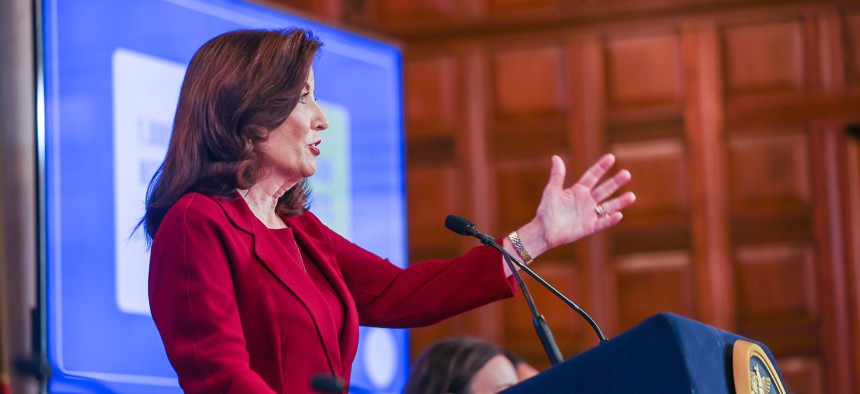Kathy Hochul
Gov. Kathy Hochul’s 2024 budget proposal, by the numbers
The governor proposed the largest state spending plan in history in her second executive budget while upholding her promise not to increase income taxes.

For the second year, the governor proposed the largest state spending plan in history while also making good on her promise to not increase income taxes. Mike Groll/Office of Governor Kathy Hochul
Gov. Kathy Hochul kicked off the always-interesting budget process for FY 2024 on Wednesday with an unveiling of the executive budget. Although the process is far from over – and will include months of negotiations with the state legislature before a final budget is approved – the governor’s proposed budget gives insight into the administration’s priorities and further details on the policies that were laid out in the State of the State address.
For the second year, the governor proposed the largest state spending plan in history while also making good on her promise to not increase income taxes.
Here are some of the top numbers you need to know to understand the governor’s executive budget.
$227 billion – the total amount of money in the executive budget proposal. This is a 2.4% increase from her first budget proposal, which had previously been the state’s largest budget proposal to date.
$19.5 billion - the amount of money the state has in reserves for the economic downturn. Hochul’s administration said the number has increased substantially in recent years – up from $3.3 billion in 2020, $3.4 billion in 2021 and $8.9 billion in 2022.
$1 billion - the amount promised to help address New York City’s ongoing migrant crisis. The administration is hopeful the federal government and New York City will also each match the $1 billion in funding to help address the crisis.
3 - the number of years the governor is proposing to extend the temporary higher corporate tax rate. The temporary higher tax rate applies to businesses with more than $5 million in revenue.
$22 billion - the total projected budget gap over the next three years. The administration estimates a $5.7 billion gap next year, a $9.0 billion gap in fiscal year 2026 and a $7.5 billion gap in fiscal year 2027.
7% - the amount the traditional aid to the MTA will increase. The budget highlights the impending financial crisis plaguing the agency and highlights savings through “operating efficiencies.” The budget also proposes increased funding from a payroll tax and increased contributions from New York City.
85 - the number of charter schools that could open in New York City with the governor’s proposed budget. New York City has hit its current charter school cap of 275. But, the budget proposes to eliminate the regional cap on the number of charters that may be issued in New York City – opening the floodgates for more charter schools in the city.
$34.5 billion – the amount of money in proposed education funding. The budget calls this amount “the largest school aid increase in history” and that figure includes $125 million to expand the full-day pre-K program to serve more than 17,000 more kids. The budget also proposed increasing school aid by more than $13 billion over the next 10 years.
2,150 – the number of new residential beds for people with mental illness who need support. The governor has prioritized addressing the state’s mental health crisis and was the first plan ahead of her state of the state address.
NEXT STORY: Takeaways from Hochul’s state budget proposal

